Summarize
Original author:@starzqeth
Summarize
Let's first use 4 questions to see the status quo
How did NFT royalties (Royalties) appear?
NFT royalties (Royalties) are the most important weapon to attract artists-based early projects, which perfectly solves the problem that creators have no income after the subsequent price surge
Do all NFTs need to rely on royalties?
Royalties must not be used as the main source of income, which is essentially inconsistent with the hodler's interests
PFP projects do not depend on royalties at all, and need to have independent business income, so as to be consistent with the interests of hodler
Non-PFP projects such as tools may still need to rely on royalties as an important income at present, but they need to have a better business model in the NFT world in the future
Art projects: royalties are the underlying business model
non-art project
Why x2y2 now allows buyers to choose 0 royalties
On the one hand, it maintains its own competitiveness (GEM integrated sudoswap with 0 royalties on the same day), on the other hand, it competes for users and gains a larger market share
Why did it cause another round of controversy on the whole network?
The transaction volume of x2y2 is larger, which will affect the interests of more project parties. Previously, the transaction volume of sudoswap was small and more people waited and watched
The buyer is given the choice of royalties, but the communication on the seller's side is a little less thoughtful
Finally, let's answer this question,Why royalty reform marks the next evolution of the NFT industry?
4 key parts of the NFT industry will be reshaped next
Business model reshaping, high-quality supply increased
Reshaping the relationship between project parties and users
Reshaping the relationship between the project party and the trading platform
Smart contract reshaping
After this round of remodeling, high-quality supply has increased, project parties and trading platforms have become more mature, projects and users have shifted from investment to consumption, and a broad market is about to open.
first level title
How NFT Royalty (Royalties) Appeared
The reason is simple. Early NFT project parties are mainly artists, and Royalties are the most important weapon for the NFT industry and OpenSea to attract project parties.
As mentioned in the previous article, there are three great innovations in the history of web3, blockchain, smart contract and ERC-721 protocol, all of which are indispensable, making artwork the most perfect use case in the early stage of NFT, but as a creator, there is a big problem. Pain points:
There is a gap between the income of the artist and the value of the artwork: the most typical example is Van Gogh, who lived a poor life with no one interested in his paintings, and the value skyrocketed after his death but did not feed back to the creator and his family. I guess this is also the reason for the inflated prices of many unknown works of art. If the price is set low, creators will definitely suffer losses. If the secondary market becomes popular after a while, the money earned by traders and the trading market has nothing to do with the original creators.
We must thank the NFT industry and OpenSea here. The innovation introduced the concept of Royalties. Every time an artwork is sold, the original author will be divided according to a fixed ratio (not just the first income), which solves the problem that the creator has no choice after the subsequent price surge. question of income. At the same time, this mechanism will also encourage creators to sell their works with a lower threshold to gain more attention.
first level title
Do all NFTs need to rely on royalties?
It can be seen that the Use Case of royalties is closely related to artworks, which better solves the problem of unreasonable income for artists. But NFT has developed to the present, artwork (1/1, Art) is just one of the tracks, do other types of projects (PFP / Pass / Tools / ... ) necessarily need royalties? The following "projects" are all defaulted as non-art projects
Royalty is the revenue method of the project side, so this question can be converted into
Does the project party necessarily need royalties as the main method of revenue?
Here is the conclusion
Royalties must not be used as the main source of income, which is essentially inconsistent with the hodler's interests
PFP projects do not depend on royalties at all, and need to have independent business income, so as to be consistent with the interests of hodler
Non-PFP projects such as tools may still need to rely on royalties as an important income at present, but they need to have a better business model in the NFT world in the future
Let's first look at the revenue methods that the project party can have. At the same time, it can be compared to a company, and the company itself has a history of hundreds of years. We will also compare the revenue methods of the two

can clearly see
There are 3 types of revenue methods for NFT projects, and transaction royalties are only one of the secondary market revenues
Whether it is a start-up company or a listed company, financing from the primary market is a means of raising funds in the initial stage, and the main income of the follow-up company is still brought by the main business (such as Disney’s IP licensing income, Apple’s mobile phone sales, and Tesla’s car sales. ), you can form a healthy business model if you can make blood
The transaction royalty income is indeed unique to NFT, and the company does not have this income. Will you give the company rebates for stock trading?
Royalties must not be used as the main source of income, which is essentially inconsistent with the hodler's interests
Make 2 extreme assumptions
A certain NFT project is particularly good. Everyone is a diamond hand hodler and does not trade. The royalties of the project party are 0. And basically all projects encourage everyone to be a diamond hand hodler
In the bear market, almost no one trades, and the royalties of the project party are 0. But the project needs funds to continue BUIDL support to get out of the bear market
first level title
PFP projects can be completely independent of royalties
image description
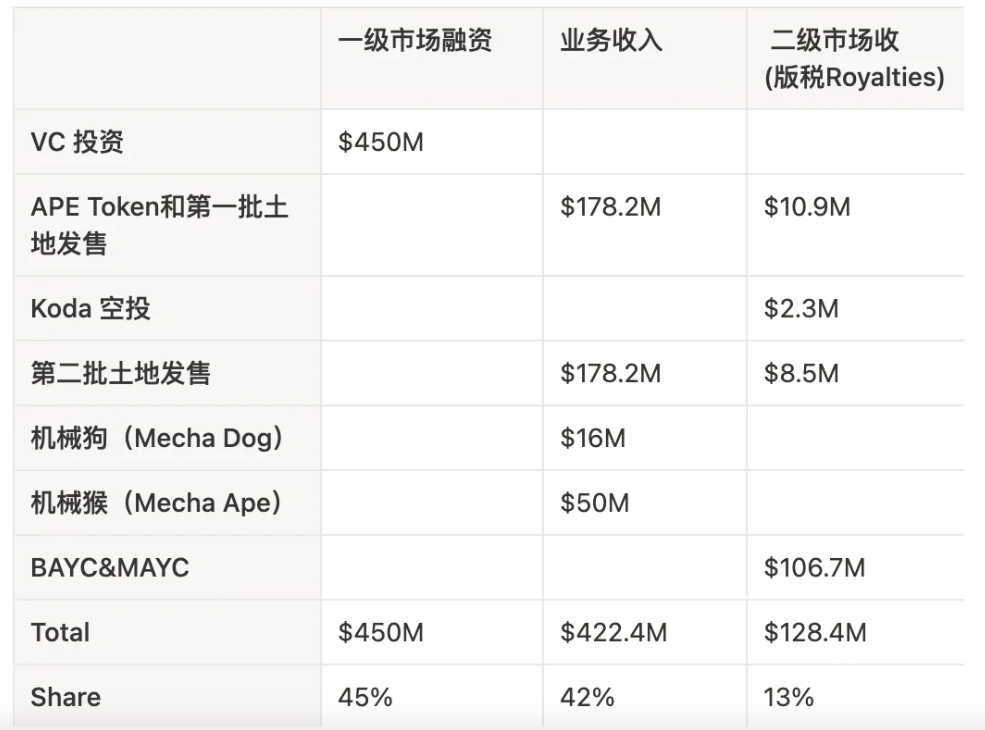
(Yuga Labs 2022 revenue forecast)
In fact, Yuga Labs only got $2.2M from the original project BAYC primary market mint, which is less than 4/1000 of the revenue in 2022.Relying on continuous BUIDL, we have the confidence to continuously develop new projects for business income, and also raised $450 million from VC.
On March 23, 2022, Yuga Labs, the parent company of BAYC, completed a new round of financing of US$450 million at a valuation of US$4 billion, this round of financing was led by a16z, with participation from Animoca Brands, Coinbase and MoonPay. Yuga Labs previously announced plans to create a virtual world called "Otherside."
In addition, for 10k PFP projects, the project party itself retains a part of NFT, and it is also a healthy way to make money through BUIDL to increase its value. Many KOLs in this area have expressed similar views. In fact, many well-known projects have used this model, including LarvaLabs (CryptoPunks/Meebits) and 8liens, setting the royalty to 0 and reserving 10%-20% for subsequent income.
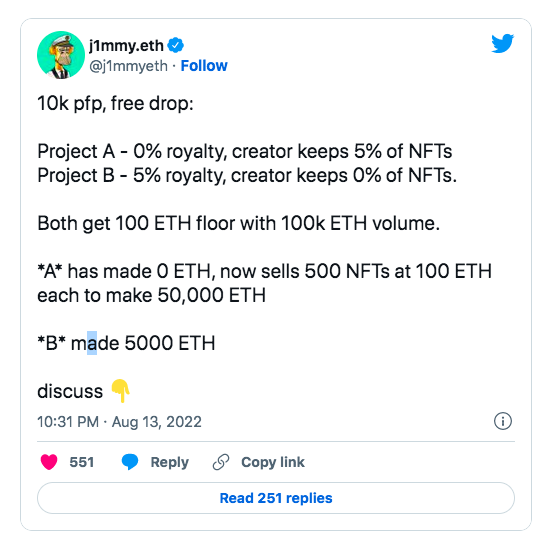
in conclusion
(10k) PFP projects are completely independent of royalties
Through continuous BUIDL to increase the value of IP, the project party can continue to earn income by retaining a part of NFT, or launching new projects, and even financing through VC
Non-PFP projects need a better business model
There will be some problems when applying the above method to non-PFP projects (such as tools)
The floor price of the tool will not be particularly high, and the number may be very small (3333 Trait Sniper Lifetime), and the project party itself retains a part of the NFT to obtain limited benefits
The extensibility of the tool is not as strong as that of the PFP class, and the probability of launching new projects is small
However, the continuous BUIDL of the tool also needs funds, so it may still need to rely on royalties as an important income at present, but in the future, it needs to have a better business model in the NFT world. Because based on the above assumptions, a certain NFT project is particularly good for everyone's diamond hands, and the royalties may be 0.
Here you can refer to the web2 world, there are three main business models of tools, toC paid subscription, toB paid and advertising, in fact, many products are also referred to
Premint Collector (toC) is valid for 2 years, and you can repurchase after 2 years, which is equivalent to an annual subscription, with new income every 1-2 years
first level title
Why does x2y2 allow buyers to choose 0 royalties at this moment, and why has it caused another round of controversy on the entire network
This part is relatively long and is divided into 4 subsections:
Background on the Royalty Controversy
What exactly are the functions added by x2y2 this time?
Why x2y2 now allows buyers to choose 0 royalties
secondary title
Background on the Royalty Controversy
Some readers are sure to be curious, is there a way for me not to pay royalties? the answer is yes
Here is a concept first,Quoting Punk6529, Royalty (Royalties) is a social convention, but not a technical convention (Royalties are a social convention, not a technical convention)
The royalties are not written in the NFT smart contract, so the project party must set the royalties on each trading platform
The trading platform can completely prevent the project party from setting royalties, such as sudoswap; or allow users to choose royalties, such as x2y2
The most vivid metaphor is "tips". Most restaurants do not require tipping, but it has become a practice in Western society as a reward for waiters.
However, it can be seen from the following controversy that royalties have not become a common practice for all projects, especially when soft rug project parties and users cut flesh
There are also always ways for users to skip royalties, such as over-the-counter (OTC)
In addition, the controversy about royalties started 2 weeks ago with the release of sudoswap’s 0 royalties. Let’s summarize it a bit (see the Reference section for details)
KOL perspective
For works of art, everyone basically has a consensus that royalties need to be used to motivate artists
For other projects, especially 10k PFP, there is also a consensus that royalties are not the best revenue solution, for the reasons we mentioned above, this will lead to second-level speculation by the project party to make money through royalties instead of real BUIDL. We can also It can be seen that countless project parties can continue to make money from royalties after soft rug, and finally users are cut leeks.
user perspective
If the project party does things in a down-to-earth way, the floor price rises, and the royalties are barely acceptable; but in the current bear market, the floor price falls, and the royalties should not be paid if they are forced to cut meat
The royalties of many projects are too high and unreasonable: many soft rug projects have received 5%-10% royalties, but BAYC's royalties are only 2.5%
Project perspective
secondary title
What exactly are the functions added by x2y2 this time?
First of all, let’s take a detailed look at the functions that x2y2 has added this time. It is up to the buyer to choose the proportion of the royalty distribution.
From the UI design point of view, this function uses a smaller gray font, and it is folded by default; at the same time, the name is "OPTIONAL ROYALTY" (optional royalty), indicating that the current positioning is a secondary or even a tertiary function. The test proactively found feedback from users of this feature.According to the common sense of click conversion rate, the utilization rate of the secondary function is about 10%.
After the user clicks "OPTIONAL ROYALTY", the default selection is 100% of the royalties to the project party (the royalty set by Azuki is 5%), and there is a red copy below to emphasize "Do consider paying royalties, so that the creators can build more for the community.” (Be sure to consider paying royalties so that creators can create more content for the community), informing users of the importance of royalties, that is to say, the choice here should be cautious
Users have 3 royalty options, 100%/50%/0%. If 100% is selected, all royalties will be given to the project party; if 50% is selected, half of the royalties will be given to the project party and half will be returned to the user; if 0% is selected, all royalties will be returned to the project party user
To expand a little bit, why is it that the buyer chooses the royalty rate when purchasing instead of the seller choosing the royalty rate? The following is my own thinking
The buyer is the one who actually pays for the project. It is more fair for the investor to choose. Is the transaction worth paying royalties for this project?
When the project party and users of soft rug cut meat, do they have to pay royalties?
If the seller chooses, it will make things complicated, unless it is one size fits all like sudoswap. Specifically, there are 2 questions
The listing process becomes complicated, and the seller needs to calculate the price set under different royalties based on the income. In addition, if the seller wants to list 2 versions at the same time, one with royalties and one without royalties, this is even more complicated
The buyer selection process has become complicated. It is not ruled out that some buyers just want to choose NFT with royalties, and an additional screening process is added to reduce user experience and transaction success rate
To sum up, x2y2 uses a secondary function to give users the right to choose royalties. At the beginning, it first tests the feedback of about 10% of users, and also establishes the ability to adjust royalties, which is better than the seller’s choice of user experience. This is also the same as last timeIn the AMA, CEO TP’s attitude of “seeing the development of the situation” when talking about royalties matches。
secondary title
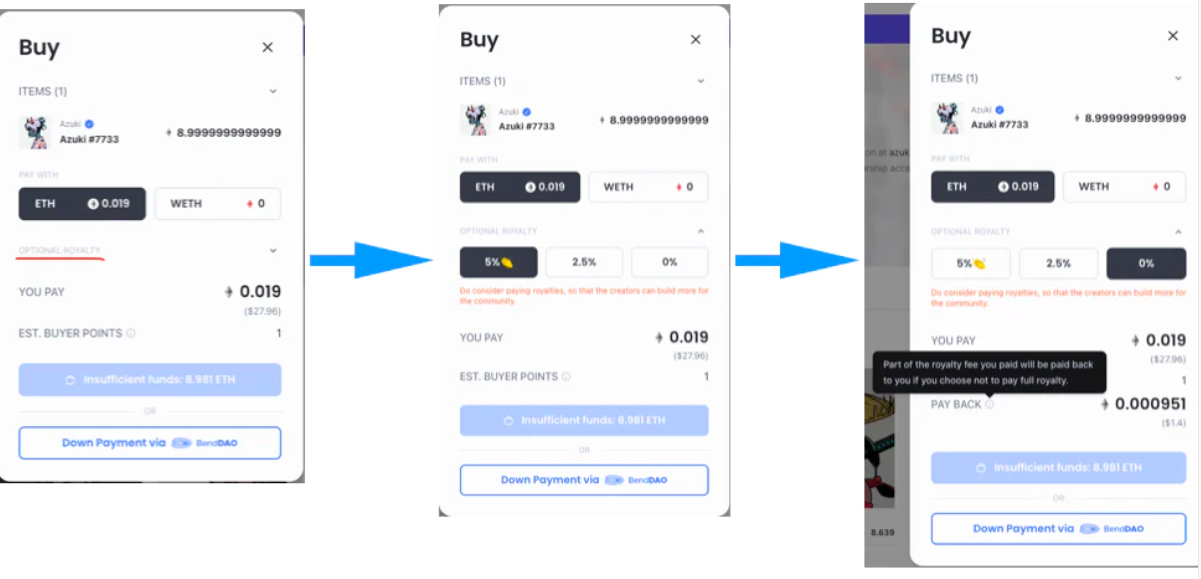
Why x2y2 now allows buyers to choose 0 royalties
The official statement is "mainstream aggregators intend to provide similar functionality in the near future. We have made the above updates to ensure that X2Y2 is ready and grasps market trends"

My own understanding, there are 2 reasons here, X2Y2 only mentioned 0.5 here, and the other 1.5 is inconvenient to say directly haha
That mainstream aggregators intend to offer similar functionality in the near future is only half the story. The "mainstream aggregator" here should refer to GEM. On the same day, GEM integrated sudoswap, and the floor prices of popular projects were all occupied by sudoswap, which will greatly weaken the competitiveness of x2y2. x2y2 is what GEM started, and it has to follow in some way. Interestingly, GEM has integrated sudoswap. I haven't seen it under these two official Twitter accounts. I guess it should be a low-key test user reaction
secondary title
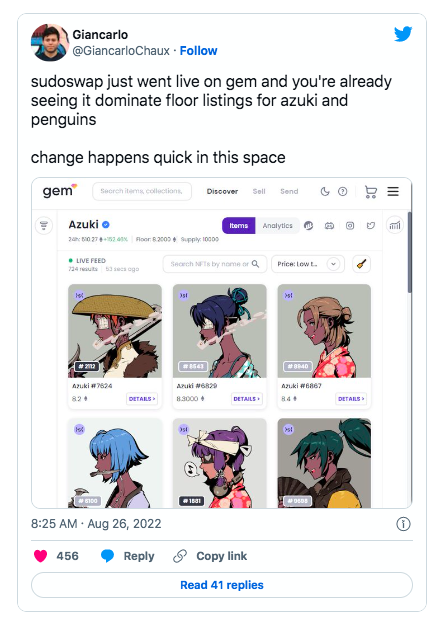
Why caused another round of controversy on the whole network
The topic of royalties had been discussed vigorously for a round two weeks ago and gradually calmed down. As a result, the new wave was even more violent. At the same time, according to my own observation, the last wave of discussions was more about the royalties themselves, and this wave is basically about x2y2. Why? I have summed up 2 reasons
The transaction volume of x2y2 is larger, which will affect the interests of more project parties. Previously, the transaction volume of sudoswap was small and more people waited and watched
according tonftgoAccording to the data, in the past 24 hours, the trading volumes of OpenSea, x2y2, LooksRare and sudoswap in the past 24 hours were $11M, $2.8M, 0.75M and $0.6M respectively (excluding wash trading). x2y2 has reached almost 30% of OpenSea's transaction volume, while sudoswap is only about 5% of OpenSea's.Zeneca33 also mentioned in the previous article that the current share of sudoswap is still small, and everyone is still waiting to see the development of the situation
The buyer is given the choice of royalties, but the communication on the seller's side is a little less thoughtful
From the perspective of project categories, it is true that PFP projects can be less dependent on royalties. There is a strong consensus on art royalties, and it is easy to be caught and criticized; tools are indeed still needed at this stage.Here's why the Coniun CEO is so excited;x2y2's response speed is indeed very fast. The next day CEO TP tweeted that royalties will be imposed on art. But it is true that this piece lacks some consideration and communication
From the point of view of options, TP tweeted that holders can vote to decide whether there is a royalty, which lacks the participation of the project party
image description

first level title
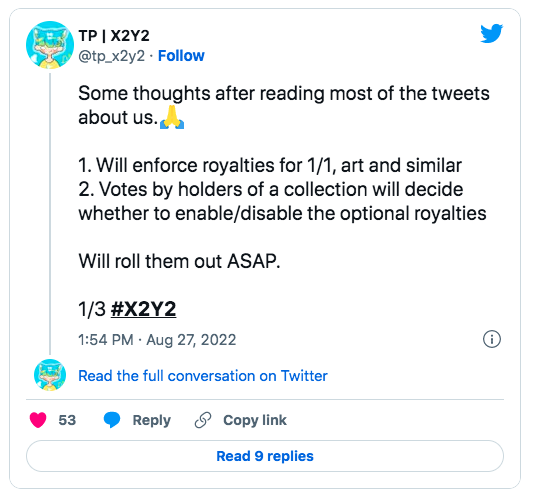
Why royalty reform marks the next evolution of the NFT industry?
Finally, returning to the title of this article, the next 4 key parts of the NFT industry will be reshaped
Business model reshaping, high-quality supply increased
Reshaping the relationship between project parties and users
Reshaping the relationship between the project party and the trading platform
Smart contract reshaping
secondary title
1. Remodeling of business model and increase of high-quality supply
It is definitely unreasonable to collect royalties for all projects in the industry, especially many soft rug projects have received 5%-10% royalties, but BAYC’s royalties are actually only 2.5%
Different types of projects need to design a healthier business model. As analyzed above, royalties alone cannot support long-term BUIDL. New projects based on IP, reserved NFT, subscription and toB charges are more diversified and healthier revenue methods
secondary title
2. Reshaping the relationship between the project party and users: setting user hierarchical rights and interests, whether users pay royalties will become an important distinguishing behavior; user consumption behavior increases
The project party will introduce a series of incentives (or equity degradation measures) to encourage users to pay royalties normally, including utility, airdrops and offline activities. Of course, this also requires that the project party needs to be sufficiently competitive, otherwise users can choose similar but lower-cost projects
The CEO of coniun tweeted that he would not provide utility to purchasers on x2y2 (really turned into JPG T_T)
6529 (joking) said that BAYC can prohibit users who have not paid royalties from subsequent airdrops, entering otherside, and participating in offline activities
secondary title
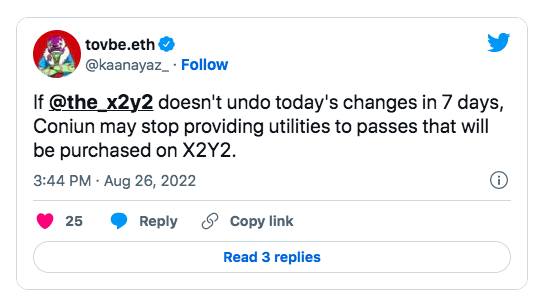
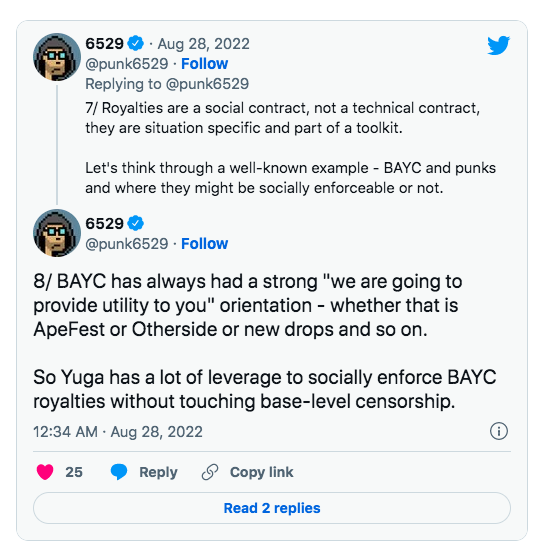
3. Reshaping the relationship between project parties and trading platforms: a small number of powerful project parties will accelerate the launch of their own trading markets
Alexander Taub, the co-founder of Truth Labs, announced on Twitter that he will launch the goblintown.wtf ecological NFT trading market within a few weeks, better regulate royalties, platform fees and suspicious NFT, and build his own ecology
It has been rumored for a long time that Yuga Labs will also launch its own trading market
TweetTweetIt is said that there is already a way to set up a whitelist, and only on which trading platforms are listed
secondary title
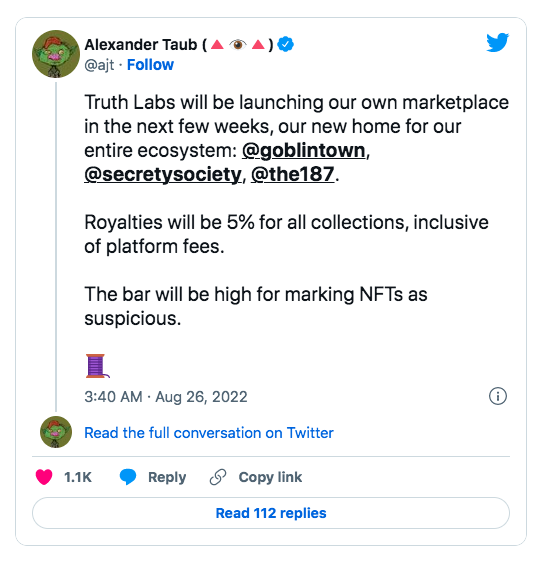
4. Smart contract reshaping, implanting royalties?
The closest thing so far isEIP-2981, to achieve standardized royalty payment information retrieval, each trading platform can choose to directly call to distribute royalties, but can also choose to use its own logic
A standardized way to retrieve royalty payment information for non-fungible tokens (NFTs) to enable universal support for royalty payments across all NFT marketplaces and ecosystem participants.
I personally don't think that upgrading the smart contract can completely solve the problems encountered by royalties. As punk6529 said, “Royalties are a social practice, but not a technical one.” What is controversial is whether royalties are reasonable and which scenarios are reasonable. Users will always have ways to avoid or even hack what they think is unreasonable.
end
end
Original link